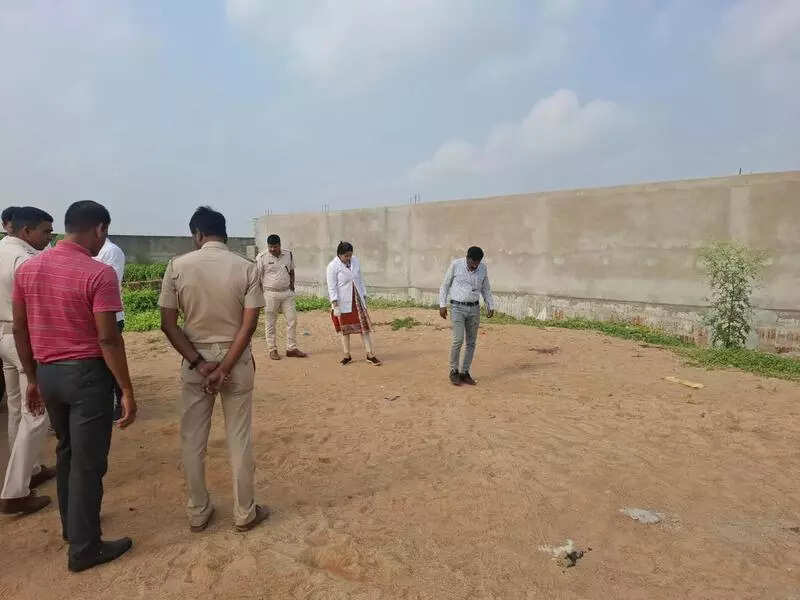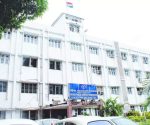Encounter decisions taken by SPs based on ground situation: DGP | Bhubaneswar News

Bhubaneswar: Director general of police P Y B Khurania has said that no specific directives have been issued to initiate shootouts, following 11 ‘non-fatal encounters’ targeting criminals across the state in under two months and three occurring on last three successive days.
The DGP emphasised that these actions were independent decisions made by SPs based on ground circumstances during their law enforcement activities.
“We are taking action against anti-socials within the framework of law. There was neither any formal nor informal order issued by the state police headquarters to carry out special ‘encounter’ drives. In all those cases, criminals opened fire at the police first,” Khurania told TOI.
Between Feb 17 and April 13, as many as 11 gunfire exchanges occurred between police and criminals in different districts, resulting in 14 criminals sustaining gunshot wounds and 16 being arrested. The capital city recorded seven arrests following shootout incidents on Feb 17, March 9, April 3 and April 11.
City police commissioner S Dev Datta Singh said that criminals are showing resistance due to intensified police action, attempting to avoid arrest. “Police resorted to firing in self-defence when faced with armed criminals. In no case did the police fire first,” Singh told TOI.
Retired police personnel and citizens supported the ‘tit-for-tat’ approach adopted by police towards serious offenders. They believed that appropriate police response to criminal attacks serves as an effective deterrent. “If criminals are not hesitating to attack police, they should be given a dose of their own medicine,” said S K Nayak, a retired SP.
Some former police officerss noted that the consistent pre-dawn timing of these encounters suggests directions from senior leadership. They indicated that officers might have received guidance to minimise fatalities and prevent legal complications.
Human rights activist Biswapriya Kanungo termed these actions “extra-judicial”. “The pattern of encounters sharing similar characteristics — non-lethal outcomes, pre-dawn or late night timing, leg injuries and regular occurrence across different locations — indicates that these encounters are stage-managed and fake,” Kanungo said.
Police officers rejected the allegations, stating operations were intelligence-based. Officers said that the suspects fired first in each case, necessitating police retaliation.
“The arrested individuals faced charges including robbery, residential theft, ATM theft, extortion, weapons trafficking, cattle smuggling, drug smuggling and sexual harassment,” a senior police officer said.
“We first issued clear warnings before engaging with the criminals. In each case, suspects fired first, compelling us to respond defensively. Injuries were primarily to lower extremities, with immediate medical attention provided,” an SP said on the condition of anonymity.
Police recovered various weapons, including country-made pistols, ammunition and stolen vehicles. Investigation teams are examining broader criminal networks. “We ensured that all encounters were conducted within legal frameworks and appropriate protocols were followed. Each operation was planned based on credible intelligence and executed with necessary precautions to avoid casualties,” the officer said.
Bhubaneswar: Director general of police P Y B Khurania has said that no specific directives have been issued to initiate shootouts, following 11 ‘non-fatal encounters’ targeting criminals across the state in under two months and three occurring on last three successive days.
The DGP emphasised that these actions were independent decisions made by SPs based on ground circumstances during their law enforcement activities.
“We are taking action against anti-socials within the framework of law. There was neither any formal nor informal order issued by the state police headquarters to carry out special ‘encounter’ drives. In all those cases, criminals opened fire at the police first,” Khurania told TOI.
Between Feb 17 and April 13, as many as 11 gunfire exchanges occurred between police and criminals in different districts, resulting in 14 criminals sustaining gunshot wounds and 16 being arrested. The capital city recorded seven arrests following shootout incidents on Feb 17, March 9, April 3 and April 11.
City police commissioner S Dev Datta Singh said that criminals are showing resistance due to intensified police action, attempting to avoid arrest. “Police resorted to firing in self-defence when faced with armed criminals. In no case did the police fire first,” Singh told TOI.
Retired police personnel and citizens supported the ‘tit-for-tat’ approach adopted by police towards serious offenders. They believed that appropriate police response to criminal attacks serves as an effective deterrent. “If criminals are not hesitating to attack police, they should be given a dose of their own medicine,” said S K Nayak, a retired SP.
Some former police officerss noted that the consistent pre-dawn timing of these encounters suggests directions from senior leadership. They indicated that officers might have received guidance to minimise fatalities and prevent legal complications.
Human rights activist Biswapriya Kanungo termed these actions “extra-judicial”. “The pattern of encounters sharing similar characteristics — non-lethal outcomes, pre-dawn or late night timing, leg injuries and regular occurrence across different locations — indicates that these encounters are stage-managed and fake,” Kanungo said.
Police officers rejected the allegations, stating operations were intelligence-based. Officers said that the suspects fired first in each case, necessitating police retaliation.
“The arrested individuals faced charges including robbery, residential theft, ATM theft, extortion, weapons trafficking, cattle smuggling, drug smuggling and sexual harassment,” a senior police officer said.
“We first issued clear warnings before engaging with the criminals. In each case, suspects fired first, compelling us to respond defensively. Injuries were primarily to lower extremities, with immediate medical attention provided,” an SP said on the condition of anonymity.
Police recovered various weapons, including country-made pistols, ammunition and stolen vehicles. Investigation teams are examining broader criminal networks. “We ensured that all encounters were conducted within legal frameworks and appropriate protocols were followed. Each operation was planned based on credible intelligence and executed with necessary precautions to avoid casualties,” the officer said.
The DGP emphasised that these actions were independent decisions made by SPs based on ground circumstances during their law enforcement activities.
“We are taking action against anti-socials within the framework of law. There was neither any formal nor informal order issued by the state police headquarters to carry out special ‘encounter’ drives. In all those cases, criminals opened fire at the police first,” Khurania told TOI.
Between Feb 17 and April 13, as many as 11 gunfire exchanges occurred between police and criminals in different districts, resulting in 14 criminals sustaining gunshot wounds and 16 being arrested. The capital city recorded seven arrests following shootout incidents on Feb 17, March 9, April 3 and April 11.
City police commissioner S Dev Datta Singh said that criminals are showing resistance due to intensified police action, attempting to avoid arrest. “Police resorted to firing in self-defence when faced with armed criminals. In no case did the police fire first,” Singh told TOI.
Retired police personnel and citizens supported the ‘tit-for-tat’ approach adopted by police towards serious offenders. They believed that appropriate police response to criminal attacks serves as an effective deterrent. “If criminals are not hesitating to attack police, they should be given a dose of their own medicine,” said S K Nayak, a retired SP.
Some former police officerss noted that the consistent pre-dawn timing of these encounters suggests directions from senior leadership. They indicated that officers might have received guidance to minimise fatalities and prevent legal complications.
Human rights activist Biswapriya Kanungo termed these actions “extra-judicial”. “The pattern of encounters sharing similar characteristics — non-lethal outcomes, pre-dawn or late night timing, leg injuries and regular occurrence across different locations — indicates that these encounters are stage-managed and fake,” Kanungo said.
Police officers rejected the allegations, stating operations were intelligence-based. Officers said that the suspects fired first in each case, necessitating police retaliation.
“The arrested individuals faced charges including robbery, residential theft, ATM theft, extortion, weapons trafficking, cattle smuggling, drug smuggling and sexual harassment,” a senior police officer said.
“We first issued clear warnings before engaging with the criminals. In each case, suspects fired first, compelling us to respond defensively. Injuries were primarily to lower extremities, with immediate medical attention provided,” an SP said on the condition of anonymity.
Police recovered various weapons, including country-made pistols, ammunition and stolen vehicles. Investigation teams are examining broader criminal networks. “We ensured that all encounters were conducted within legal frameworks and appropriate protocols were followed. Each operation was planned based on credible intelligence and executed with necessary precautions to avoid casualties,” the officer said.
Bhubaneswar: Director general of police P Y B Khurania has said that no specific directives have been issued to initiate shootouts, following 11 ‘non-fatal encounters’ targeting criminals across the state in under two months and three occurring on last three successive days.
The DGP emphasised that these actions were independent decisions made by SPs based on ground circumstances during their law enforcement activities.
“We are taking action against anti-socials within the framework of law. There was neither any formal nor informal order issued by the state police headquarters to carry out special ‘encounter’ drives. In all those cases, criminals opened fire at the police first,” Khurania told TOI.
Between Feb 17 and April 13, as many as 11 gunfire exchanges occurred between police and criminals in different districts, resulting in 14 criminals sustaining gunshot wounds and 16 being arrested. The capital city recorded seven arrests following shootout incidents on Feb 17, March 9, April 3 and April 11.
City police commissioner S Dev Datta Singh said that criminals are showing resistance due to intensified police action, attempting to avoid arrest. “Police resorted to firing in self-defence when faced with armed criminals. In no case did the police fire first,” Singh told TOI.
Retired police personnel and citizens supported the ‘tit-for-tat’ approach adopted by police towards serious offenders. They believed that appropriate police response to criminal attacks serves as an effective deterrent. “If criminals are not hesitating to attack police, they should be given a dose of their own medicine,” said S K Nayak, a retired SP.
Some former police officerss noted that the consistent pre-dawn timing of these encounters suggests directions from senior leadership. They indicated that officers might have received guidance to minimise fatalities and prevent legal complications.
Human rights activist Biswapriya Kanungo termed these actions “extra-judicial”. “The pattern of encounters sharing similar characteristics — non-lethal outcomes, pre-dawn or late night timing, leg injuries and regular occurrence across different locations — indicates that these encounters are stage-managed and fake,” Kanungo said.
Police officers rejected the allegations, stating operations were intelligence-based. Officers said that the suspects fired first in each case, necessitating police retaliation.
“The arrested individuals faced charges including robbery, residential theft, ATM theft, extortion, weapons trafficking, cattle smuggling, drug smuggling and sexual harassment,” a senior police officer said.
“We first issued clear warnings before engaging with the criminals. In each case, suspects fired first, compelling us to respond defensively. Injuries were primarily to lower extremities, with immediate medical attention provided,” an SP said on the condition of anonymity.
Police recovered various weapons, including country-made pistols, ammunition and stolen vehicles. Investigation teams are examining broader criminal networks. “We ensured that all encounters were conducted within legal frameworks and appropriate protocols were followed. Each operation was planned based on credible intelligence and executed with necessary precautions to avoid casualties,” the officer said.
















